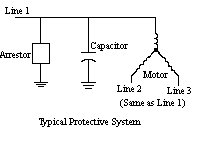Transient Voltage Conditions
During recent years substantial evidence has come to light indicating that a significant number of large motors are exposed to transient voltage conditions which result in reduced winding life or premature failures (either turn-to-turn or turn-to-ground).
Under the certain circumstances, these transient voltages can be caused by any of the following power system conditions:
- Lightning strikes, direct or indirect.
- Capacitor switching.
- High speed contactor operation. (Automatic line reclosers)
- Distribution system failures.
- Repetitive restrikes (arcing).
- Intermittent grounds.
Estimates of the magnitude of these surges normally range from two to five times the normal line-to-neutral crest voltage with rise times ranging from .1 u seconds (microseconds) to 10 u seconds.
Typical Transient Voltage Wave Front

Motor Limitations
The motor manufacturer normally does not have sufficient application information available to determine when to include surge and lightning protection in the motor. However, he can determine the surge limits which the motor can withstand and still give satisfactory life. These limits are established as follows:
- The instantaneous step portion of the surge voltage (VI) shall not exceed the crest value of the normal line-to-neutral voltage (VLN).
i.e. VI = VLN x SqRoot(2) - The maximum surge voltage shall not exceed 1.25 x the crest voltage of the standard 1 minute 60 Hz hi-pot test. 3
i.e. VM = 1.25 SqRoot(2) (2VL + 1000) - The rate of the surge voltage (VM) shall not exceed a rate based on reaching VM in less than 10 u seconds. 3
i.e. VM / 10 = volts / u sec.
Care must be taken not to exceed the instantaneous voltage (VI), the maximum peak voltage (VM) or the rate of rise (VM / 10) when selecting surge capacitors or lightning arrestors.
Recommended Guide For Selection of Surge Capacitors & Lightning Arrestors
| Max Motor Rated Voltage |
Maximum Peak Voltage (VM) in KV |
Maximum Rate of Rise in KV/u Sec |
| 600 | 2.3 | .6 |
| 2400 | 10 | 1.0 |
| 4160 | 16 | 1.6 |
| 4800 | 19 | 1.9 |
| 6600 | 25 | 2.5 |
| 6900 | 26 | 2.6 |
The table above indicates the maximum withstand voltages (VM) and rate rise for TITAN Line Motors.
For applications where the values in the table above are exceeded, it is recommended that a special insulation system with increased dielectric strength be used (turn-to-turn and turn-to-ground) or that surge capacitors and / or lightning arrestors be utilized. From an availability and economic standpoint the latter alternative should be used.
Testing
We test each stator coil turn-to-turn using a low impedance high frequency coil analyzer to insure withstand capability to the above limits. As added insurance, after the stator is wound, the turn-to-ground insulation is also tested using an A. C. Hypot tester.

Surge Protection and Lighting Arrestors
Lightning arrestors limit the magnitude of the transient voltage spike. This is achieved by the arrestor conducting to ground when the voltage reaches a given value. Surge capacitors limit the rate of rise of the voltage. This is achieved by the capacitor momentarily absorbing some of the initial energy thereby slowing down or sloping the steep wave front.
System
VoltageCapacitor Rating Arrestor Rating ( KV ) UFD
RMS
600 1.0 .6 .65 2400 .5 2.4 3.0 4160 .5 4.16 4.5 4800 .5 4.8 6.0 6600 .5 6.6 7.5 6900 .5 6.9 7.5
Recommended Application of Capacitors & Arrestors
The surge capacitor should be located between the motor and the lightning arrestors and as close to the motors as possible for maximum effectiveness (limiting capacitor lead length to 3 feet is recommended). Fusing of the arrestors or capacitors is not recommended because of the difficulty in determining if or when the fuse has blown.
Appendix
- For additional information pertaining to location of lightning arrestors and grounding methods, refer to reference ( 1 ).
- For method of estimating expected surge voltage using traveling wave theory, refer to reference ( 2 ).
References
- R.W. Power, A. R. Hileman, M. Maxwell, "Lightning Protection of Rotating Machines Directly Connected To Overhead Lines", IEEE Paper 62-199.
- Franz X. Forstmaier, "Motor Surge Protection: At The Bus Or At The Motor",
IEEE Transaction On Industry & GA Vol. 1 GA-1 #5, p. 349-360. - "Impulse Testing Of Rotating A. C. Machines", IEEE Committee Report Paper, 60-125.
- "Surge Protection For Rotating A. C. Machines", Westinghouse Application Data, 1956, p. 38-423.
- G. E. McCann, E. Beck, L. A. Finzi, "Lightning Protection For Rotating Machines", AIEE Vol. 71, Dec. 1952, p. 1028.

